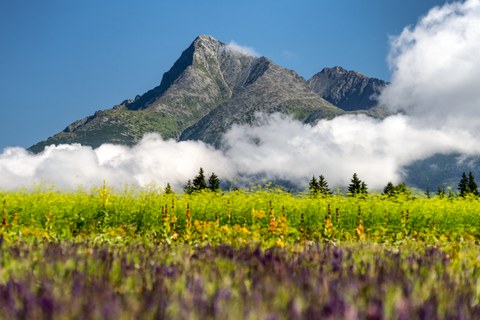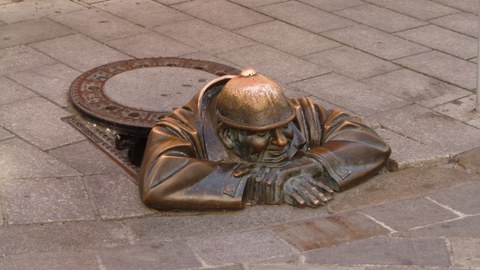Partner Country of the Month November 2024: Slovakia
Slovakia, not to be confused with Slovenia, lies south-east of the Czech Republic and in between Poland, Austria, Hungary and Ukraine. This small country is packed full of natural beauty - from the High Tatras at the northern border, Europe's smallest alpine mountain range, to rocky karst landscapes full of caves and wild gorges, and the many lakes of the Danubian plain. Slovakia is also famous for its extraordinary number of picturesque castles and palaces. There is plenty to discover!
With the "Partner Country of the Month" campaign, we want to shine a spotlight on the wide diversity of countries, regions and partner universities of TU Dresden that our students can explore during a semester abroad.
Table of contents
General facts and figures about Slovakia
Capital: Bratislava
Population: 5,4 Millionen (2024)
Official language: Slovak
National holiday: 1 September (1992) - Constitution Day of independent Slovakia
Currency: Euro
You can find further facts, figures and information on Wikipedia or on the website of the German Federal Foreign Office. For travel info, see slovakia.travel and Wikivoyage.
Language matters
- Hello / See you – Ahoj [ahoi]
- Good day – Dobrý deň [dobree dyen]
- Excuse me – Prepáčte [prapawchteh]
- Please – Prosím [proseem]
- Thank you – Ďakujem [dyakooyem]
- Yes / No – Áno [awno] / Nie [nyeh]
- I don’t understand – Nerozumiem [narozumyem]
- Goodbye – Dovidenia
Together with Czech, Polish and Sorbian, Slovak forms the Western branch of the Slavic language family. It most closely resembles Czech, and after getting accustomed to the different ways of pronunciation, the two languages are mutually intelligible. Slovak is generally considered to be particularly easy to comprehend for speakers of other Slavic languages and is therefore also known as the "Slavic Esperanto".
Slovak spelling is dotted by many diacritics, such as Ď or Ŕ. These count as separate letters, making the Slovak alphabet the longest of any European language. What seems complicated actually has a big advantage - every distinct phoneme has its own letter, so spelling is completely unambiguous.
Our partner universities offer a wide range of courses in English. Studying entirely in English during your exchange is absolutely possible. However, please check your chosen university's exact requirements before applying.
You also don't need to fear the language barrier in everyday life. Younger Slovaks in urban areas usually speak English. With older Slovaks you may be more lucky with German or Russian. However, learning Slovak will certainly help you get to know the country and put a smile on people’s faces. There is a range of high-quality free online resources, such as slovake.eu, e-slovak.sk and ucimesaslovencinu.sk.
Did you know that ....?
- in Slovak trains, students under 26 travel for free? Zero-fare tickets are available to students from EU member states (citizens and permanent residents) as well as students of any nationality who are enrolled at a Slovak university. Perfect for exploring the country during your semester abroad!
-
you are not the first to confuse Slovakia with Slovenia? Not only do the two countries share a similar name but also similar flags, and both are located in south-eastern Central Europe. This has often been the cause of misunderstandings. For example, the Slovak team was greeted with the Slovenian national anthem at the 2017 Ice Hockey World Championships, and Slovenia's Prime Minister has been declared a Slovak more than once by his international counterparts. But why do the names so closely resemble each other? Both are derived from the Proto-Slavic self-designation Sloveni.
-
a Slovak invented a working umbrella-like parachute? In 1912, aviation enthusiast Štefan Banič witnessed a tragic plane crash, leading him to think about ways for pilots to escape accidents. In his unusual design, the parachute is strapped to the wearer's body and opens underneath the arms. Banič himself demonstrated his parachute by jumping from a 15-story building and later from a plane. The US Air Force bought the patent, but it was never put to large-scale use.
-
the capital of Slovakia has a twin city? Bratislava and Vienna are closely connected, both culturally and economically. On the one hand, their shared history within the former Austro-Hungarian Empire left traces such as the lively coffee house culture in both cities. On the other hand, they are located at an extremely close distance – only 55 kilometres as the crow flies, or 50 minutes by train. Development projects are therefore often planned jointly.
-
a hyphen literally divided Czechoslovakia? From 1918 onwards, Slovakia and its current neighbour Czechia formed a joint state. However, after the fall of socialism in 1989, tensions in the country came to a clash in the so-called Hyphen War. While the Slovak side demanded more emphasis on both nationalities by changing the name to ‘Czecho-Slovakia’, the Czech side rejected this as separatism. Despite lengthy discussions, no agreement could be reached, so the two countries separated peacefully. Today, they maintain good relations.
Cooperations with Universities in Slovakia
You can find all cooperations of TU Dresden in our database. Have a look at the experiences of our previous exchange students at Questionnaires. Professors at your faculty may have direct contacts to your partner university of choice and can advise you.
Our cooperations with Slovakian universities are part of Erasmus+. You can find the contact persons and application deadlines for your faculty here.
Our Erasmus+ partner universities in Slovakia
- University of Economics in Bratislava
- Business Administration and Economics
- Technická univerzita v Košiciach (in Košice)
- Business Administration and Economics
-
Žilinská Univerzita v Žiline (in Žilina)
- Transport Engineering
- Transport and Economics
- Electrical Engineering and Information Technology
- Technical University in Zvolen
- Forestry
Don't miss...
Slovenský Raj. For the more daring souls, "Slovak Paradise" lives up to its name. This national park is famous for its many adventurous hiking trails, leading on via ferratas and ladders through gorges and along waterfalls. Another highlight of the park is Dobšinská ice cave, a UNESCO World Heritage Site. Even in summer, layers of ice up to 26 metres thick with icefalls, ice stalagmites and columns fill the cave.
Statue hunting in Bratislava. Scattered around the streets of Slovakia's capital, a variety of curious statues make for great photo spots. A tightrope walker, fairy-tale motifs, an eccentric Bratislava resident from history - there is always a surprise waiting around the corner. Probably the most well-known statue is Čumil, a worker peering out of a manhole, who, according to the accompanying sign, is of course working very hard.
Bojnický Zámok. In a country as rich in castles and palaces as Slovakia, Bojnice Castle is among the most famous ones. Its history reaches back to almost a millenium. Through the centuries, the castle was altered to fit the changing tastes, most recently in a 19th century romantic style, making it a popular setting for fairy-tale films today. You can visit magnificent rooms with original furnishings, an art history exhibition about the castle, and the adjoining flowstone cave. Don't forget to check the event calendar to not miss out on events like the International Festival of Ghosts and Spirits. It's best to book your castle ticket online in advance.
The Blue Church of Bratislava looks like it was covered in sugar frosting. Its early 20th century Art Nouveau architecture combined with the extraordinary blue colour make the church a real eye-catcher. While the exterior can always be visited, the interior only opens during daily services and prayers. This means that admission is free, but be careful to maintain silence.
Let's get cooking...
Slovak cuisine is hearty and rich, with potatoes, dairy products, sauerkraut and meat as typical ingredients. A wide range of flavourful soups and stews is perfect for cold days, such as cesnačka, a garlic soup traditionally served in a hollowed-out loaf of bread, or kapustnica, sauerkraut stew with mushrooms, a must-have on festive days like Christmas and New Year's Eve.
When it comes to sweets, cakes and pastries filled with poppy seeds, nuts, or cream cheese are very popular. A specialty from Bratislava are Bratislavské rožky, croissants made from a sweet yeast dough stuffed with nuts and poppy seeds. Traditionally, poppy seeds symbolise wealth in Slovakia, which is why they form part of many festive dishes, such as sweet poppy seed pasta.
Demikát
This dish combines Slovak passions - the sheep's cheese bryndza, homemade potato dumplings called halušky, and a hearty soup. Bryndza and halušky are a formidable comination that is often enjoyed in a fashion resembling German-Austrian Käsespätzle - large quantities of it are devoured at the eating contest at Halušky Festival. In Germany, bryndza is hard to come by, so we substitute feta cheese. If you enjoy it, a semester abroad in Slovakia to try the original is probably unavoidable. :)
Ingredients for 2 servings
For halušky:
- 350 g potatoes
- 250 g flour
- salt
For the soup:
- 250 g Feta cheese
- 1 onion
- oil or butter for frying
- 1 tsp. paprika
- 1 tsp. caraway seeds
- salt and pepper
- sour cream to taste
Preparation:
Halušky:
- Peel and grate the potatoes, then mix with flour and salt. The dough should have a gooey consistency - if necessary, add a little more water while mixing.
- Fill a pot with salted water and bring it to boil, then have it simmer over low heat.
- Add in the dough to the water, ideally, by passing it through a rough sieve. As an alternative, you can use a coarse grater or divide the dough into small portions in another way.
- After adding the dough to the water, stir and let the halušky cook until they rise to the surface. Skim them off and keep the cooking water for preparing the soup.
Soup:
- Dice the onion and fry it in a pan greased with oil or butter.
- Add the caraway seeds, paprika powder and feta cheese, and mix well.
- Add 1 litre of the cooking water you kept from preparing the halušky. Bring to a boil and then let it simmer until the onions are soft - it shouldn't take long.
- Blend to get a smooth soup. Season with salt and pepper and add sour cream to taste.
- Serve the soup and halušky together. Dobrú chuť!
(Many thanks to slovakia.travel!)
Contact
Have you had a great time in Slovakia? Do you have tips for places and experiences that are not to be missed? We would be happy to share your experiences here, on social media or, if you want, in information events for other TUD students. Get in touch with us:
 © Sven Ellger/TUD
© Sven Ellger/TUD
Advice on studying abroad
NameMs Federica Serra
Infocenter/ Study abroad; TUDworldwide: America
Send encrypted email via the SecureMail portal (for TUD external users only).
Visiting address:
Fritz Foerster Bau, Office 161 Mommsenstraße 6
01069 Dresden
Postal address:
TUD Dresden University of Technology International Office
01062 Dresden
Office hours:
- Tuesday:
- 09:30 - 11:30
- 12:30 - 14:30
- Thursday:
- 09:30 - 11:30
Please register at the SCS (FOE, floor 0).
Partner Countries Archive
Have you missed a partner country? No worries! Here you can read up on all articles.
|
Europe (Erasmus+) |
|
|
Africa |
|
|
America |
|
|
Asia |
|
|
Australia and Oceania |
|








